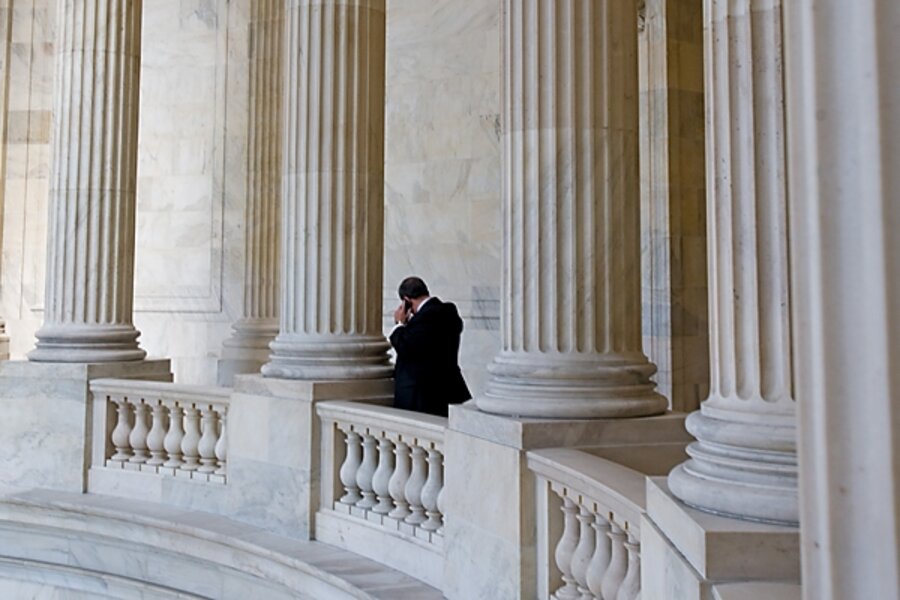The lobbyist through history: villainy and virtue
Lobbyists have besieged the US government for as long as it has had lobbies.
One of the first was William Hull, an ex-Revolutionary War officer who in 1792 was hired by fellow veterans from Massachusetts to press a claim for back pay they felt the nation still owed them for winning its liberty. Mr. Hull – a proud-looking sort with luxuriant hair – traveled to Philadelphia (then the nation’s capital) and discovered that no other state had sent a similar representative.
So he did what any modern K Street operative might do – he rounded up a coalition. He sent letters to veterans groups around the country, urging them to dispatch agents just like him to help Congress make up its mind.
Unfortunately, at the time, US finances were not exactly stable (sound familiar?) and Hull failed, mostly.
Later in life, he became the first governor of the Michigan Territory, and surrendered Detroit to the British in the War of 1812 under debatable circumstances. He was tried for treason and sentenced to be shot. President Madison reprieved him due to his Revolutionary service.
Hull’s career thus sums up three primary tenets of the lobbyist’s art:
1. Lobbying is a scramble. It’s not just quiet meals with powerful people – Hull talked to President Washington as often as he liked. You’ve got to keep moving, find allies, cover all the many arms of the government involved in your issue.
2. Lobbyists lose as often as they win. Getting something done in Washington is hard – just look at what’s happening with healthcare reform. Yet the city is full of lobbyists and trade associations engaged in the Sisyphean task of trying to get Congress to accept a particular legislative provision, or the bureaucracy to agree to their interpretation of a disputed regulation.
3. Some lobbyists experience spectacular personal flameouts. Yes, that treason conviction is kind of an outlier. But what about Sam Ward? The “King of the Lobby,” got hauled before Congress in 1875 on suspicion that he’d distributed $100,000 in bribes. And then there’s Jack Abramoff, who in 2006 pleaded guilty to conspiracy to bribe public officials. “Can you smell money?!?!?” Mr. Abramoff once wrote to an associate about a pending deal.
“Congress has always had, and always will have, lobbyists and lobbying,” said Sen. Robert Byrd (D) of West Virginia in a 1987 floor speech. “We could not adequately consider our workload without them.... At the same time, the history of the institution demonstrates the need for eternal vigilance to ensure that lobbyists do not abuse their role.”
Commercial interests have lobbied the government from its first days. An early petition received by the Continental Congress was one from merchants desiring an end to the molasses tax.
By the 1850s, the armsmaker Samuel Colt was passing out gift pistols in Washington in an attempt to get Congress to extend his patent on revolvers. One was presented to the son of a representative, a boy of 11 or 12, according to Senator Byrd’s research.
That sort of theme earned lobbyists a poor reputation. Walt Whitman called them the “lousy combings and born freedom sellers of the earth.”
Sam Ward, for his part, was the Jack Abramoff of his era. Sometimes he sent letters on the stationary of congressional committees, as a sort of hint about his clout. He could often be found at Welcher’s restaurant, advising the chef and entertaining clients, often from steamship companies and railroads. (Abramoff owned his own restaurant, “Signatures.” It’s closed.)
The House first required lobbyists to register in 1876. By the Progressive Era of the early 1900s, attempts to rein in excesses were in full gear. Success came piece by piece, however. It wasn’t until 1946 that Congress passed the Federal Regulation of Lobbying Act, which required more extensive disclosures, defined who constituted a “lobbyist,” and made disclosure of lobbying expenditures the law.
By then, lobbying had taken on a recognizably modern shape, with membership associations organized by industry, and diverse lobbying firms composed of lawyers and former Hill aides.
The cutting-edge lobbyist of the time was Tommy Corcoran, who’d been FDR’s chief political aide. “Tommy the Cork ” was one New Dealer whose idealism was tempered by a high regard for the dollar value of playing on the side that paid best.
“Once you get into this business you’ve got to be a draft horse and you’ve got to wear blinders,” said Mr. Corcoran in a conversation tapped by the FBI.
Corcoran’s genius was in seeing that clients needed guides to the vast federal bureaucracy spawned by World War II and New Deal policies. And who better to guide than a New Deal architect? From this developed today’s revolving door, through which not just top officials but lower-ranking aides and subsecretaries move to higher pay at K Street firms after a stint in government.
And the pay can be astronomical, by D.C. standards. In three years in the late 1990s, Abramoff and his primary business partner took in $66 million from six Indian tribe clients, alone.
“Da man! You iz da man!... How much $$ coming tomorrow? Did we get some more $$ in?” wrote Abramoff in an e-mail message released by prosecutors.
Abramoff is now in federal prison, following his conviction for trading gifts and meals for political favors, among other crimes. He probably will not be released until late 2011.
==
Also in this series:
How Washington lobbyists peddle power
When Gates stared down the F-22 lobbyists





